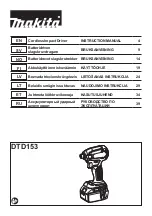
English
11
· When the charger is not operated, disconnect it from the
power supply.
· Before cleaning the charger, disconnect it from the power
supply.
· Do not expose the charger to frost, do not dip it into water or
another liquid.
WARNING!!
Prevent penetration of liquids into the charger as it could result in
electric shock. Do not let the machine in a hot environment so that
the accumulator may cool after use.
Putting into operation
Switching-on
By depressing the operating push button (4) and by its holding you
can control speed smoothly.
Switching-off
By releasing the operating push button (4). Runout of the spindle
with the chuck is reduced by the activated brake.
Lower revolutions are suitable for guiding the bolt/screw into the
material or for centre drilling of the material. Higher revolutions
are suitable for screwing the bolt into the material, for bolted joint
tightening or for drilling through the material.
Attention!
Long-time use of variable rotating speed is not recommended as
its can result in operating push button damage.
Changed direction of rotation
Direction of rotation is changed by the change over switch of the
sense of rotation (3):
· By pushing from the right to the left - right run.
· By pushing from the left to the right - left run.
· Push button in the interposition - protection from unintentional
switching.
Attention!
If you wish to change position of the change over switch, check at
first that the operating push button is released.
Note:
During first use of the device and during the first change of
the sense of rotation a loud click can be heard. It is a normal
phenomenon which cannot be considered any problem.
Tool clamping
When putting drills/extensions on, always proceed as follows:
1. Move the sleeve (1) onward and hold.
2. Put the requested drill/extension into the hole.
3. Release the sleeve; it will return to its normal position.
Tool removal
When removing/replacing the drills/extensions, always proceed as
follows:
1. Move the sleeve onward and hold.
2. Take the drill/extension out of the hole.
3. Release the sleeve; it will return to its normal position.
Instructions for use
Set the device on the nut/screw in the switched off state only.
Torque depends on stroke duration. The max. torque follows from
individual torques reached by the strokes. The maximum torque
can be reached after ca 5 seconds of strokes. After this time period
the torque rises only very moderately, but the stroke mechanism is
heated noticeably.
Due to excessive heating all stroke parts are worn materially and
consumption of the lubricating grease is very high.
Stroke duration has to be determined for each requested torque.
The really reached torque has to be checked continuously by the
torque wrench.
Two characteristic types of connection are differentiated for
use:
Hard connection:
screwed (bolted) connection of two or more,
usually metal parts which do not spring, when being tightened
and also are not deformed by the assumed pressure.
Soft connection:
screwed (bolted) connection of two or
more parts, at least one of which is of such material or of such
workmanship that is deformed by the assumed pressure or that
springs.
In case of hard connection the screws of the following mechanical
properties can be screwed firmly:
(Classes of strengths of bolts and nuts pursuant to ČSN EN 20 898-1)
The requested time of tightening is determined roughly by the
attached diagram.
The tightened parts have to be checked individually, case by case,
depending on their kinds. Acting of strokes longer than 5 seconds
does not affect increase of the torque anyhow,
Screws of smaller sizes may be tightened only by the soft
connection; time of tightening must be shorter than 1 s not to
damage the screws.
If high load has to be applied on the bolted joint for a longer time
period, e.g. loosening of excessively tightened or rusted screws,
the machine has to be unloaded regularly and the mechanism
cooled by the idle run!
Maintenance
Instructions for tool cleaning
Start the motor and blow impurities and dust out of the vent holes
of the device. Use protective goggles for this operation. Clean the
external plastic parts by a wet rag and mild detergent. Though
these parts are made of the materials resistant to solvents, NEVER
use any solvent.
Instructions for cleaning the charger
Impurities and dust can be removed from external charger surfaces
by a rag or a non-metal brush. Use neither water nor detergents.
0
5
(s)
4
3
2
1
5
10
15
20
25
30
M8
M6
M5
M4
(Nm)
t (s)
M4
M5
M6
M8
1
2 Nm
3 Nm
8 Nm
11 Nm
2
2,5 Nm
6 Nm
13 Nm
18 Nm
3
3 Nm
8 Nm
16 Nm
22 Nm
4
3,5 Nm
9 Nm
18 Nm
24 Nm
5
4 Nm
10 Nm
19 Nm
25 Nm
Summary of Contents for ASR 7 E
Page 1: ...Návod k používání Návod k používaniu Instructions for use ASR 7 E ...
Page 3: ... 1 2 2 3 4 5 6 7 8 ...
Page 13: ...13 ...
Page 14: ...14 ...
Page 15: ...15 ...


































